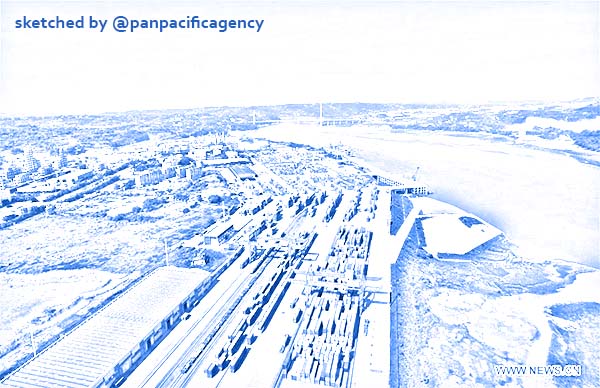[Analytics] Pitfalls of competitive connectivity in Asia

Photo taken on May 17, 2017 shows Luzhou port of China (Sichuan) pilot free trade zone in southwest China's Sichuan Province. China has released an overall plan about the country's new western sea-land transportation channel to deepen the sea-land two-way opening-up and the development of western China, according to the National Development and Reform Commission. The plan covers the period from 2019 to 2025 with an outlook extended to 2035. (Xinhua/Xue Yubin). Sketched by the Pan Pacific Agency.
Geopolitical competition between the United States and China is most tangible in Asia. In 2011, Washington responded to China’s growing influence in the region with its ‘Pivot to Asia’. Two years later, Beijing countered with its Belt and Road Initiative (BRI) — a US$1 trillion infrastructure development program connecting Asia with Europe via land, sea and the polar route. Although promoted as a way to improve regional integration and economic growth, the BRI is widely viewed as China’s grand strategy to maximise its global clout. Jürgen Rüland specially for the East Asia Forum.
The BRI triggered competing infrastructure schemes. In 2015, Japan launched its ‘Partnership for Quality Infrastructure’ and in 2016, ASEAN amended its Master Plan on ASEAN Connectivity. Then in 2018, the United States passed the Better Utilization of Investments Leading to Development (BUILD) Act and the European Union released its EU–Asia Connectivity scheme.
Connectivity has become the buzzword for poor countries in the process of jump-starting industrialisation and for more advanced economies trying to avoid the middle-income trap. Most Asian countries want a share of the infrastructure cake. Infrastructure is a prerequisite for economic growth, but there are big questions about its sustainability.
As donors compete for projects with the strategic objective of strengthening their influence in recipient countries, projects must be affordable and implemented quickly. China seeks to increase its attractiveness as a partner by promising speedy planning and implementation without the intrusive conditionalities of multilateral donors like the World Bank and most Western donors. This prompted even Japan — a member of the OECD Development Assistance Committee and the Asian Development Bank — to announce faster project execution. Other donors like India, South Korea, Thailand and Malaysia are, like China, more interested in effective project completion than in social and environmental sustainability.
Many infrastructure projects ignore best practices. Dam projects, special economic zones, railways, roads and power plants can displace those living on or near project sites. Many are resettled with little, no or markedly delayed compensation. Subsistence farmers, fishermen and indigenous people lose their livelihood and face permanent poverty. Stakeholder consultation is absent and jobs remain an empty promise. Chinese contractors often bring their own workforce, while in other cases the bulk of jobs go to internal migrants.
Special industrial zones — celebrated as providing mass employment — rarely live up to this promise as they have long gestation periods of up to 10 years before becoming fully operational. The jobs they provide offer low pay and poor working conditions.
On the environmental front, the dams along the Mekong, the Salween and their tributaries negatively impact sedimentation, fish migration and biodiversity. They cause soil erosion and the salinisation of the Mekong Delta. This severely endangers inland fisheries and agriculture in Southeast Asia’s rice bowl, which depends on sediment flow.
While China and Japan seek to produce clean energy at home, they still finance and export coal-fired power plants to many parts of Asia. Although they cease to export subcritical low-efficiency coal technology and now build ‘supercritical’ and ‘ultra-supercritical’ plants, the great number of plants planned or under construction will markedly increase carbon dioxide emissions. Coal-fired power plants also emit other pollutants like toxic gases, coal ash and acid rain, causing serious health problems for people living near the sites.
Apart from the unbridled competition among provider countries, another reason for the low social and environmental standards of many infrastructure projects is the developmental state model that catapulted Asia’s economic frontrunners to advanced economies within a short time. Developing countries seek to kick-start rapid industrialisation and economic growth with state regulation of markets, advancements in productivity, close interaction between state and business elites, a strong state that tightly controls civil society and a belief in technocratic rationality. Commitments to equality, social welfare and environmental sustainability are largely absent.
As China and Japan seek to persuade aid recipients to follow their developmental state model, many infrastructure projects reflect traits of the developmental state in a path-dependent way. They prioritise rapid economic growth and industrialisation over social and environmental concerns. For the developmental state, aggregate gains count while individual suffering caused by rapid modernisation takes a backseat. Contractors are often state-owned enterprises or companies closely linked to the state. Civil society protest against the projects is muzzled by local authorities and problems are believed to be solvable by advanced technology.
This is not an argument against infrastructure modernisation. It is an appeal for socially and environmentally sustainable infrastructure. The infrastructure programs championed by Western donors in the 1960s and 1970s and the great number of ‘white elephants’ they produced, stimulated learning the hard way. Meanwhile, international organisations such as the International Commission on Large Dams, the United Nations, the World Bank and the OECD have set standards for sustainable infrastructure.
There is no need to repeat the mistakes of the past. As geopolitical competition in Asia intensifies, embracing best practices can help the region’s infrastructure development to evade a race to the bottom in environmental policy and prevent the production of a large cohort of losers as a result of modernisation. The recent Cambodian decision to put on hold plans for two mainstream Mekong dams indicates re-thinking in the right direction.
Jürgen Rüland is Professor Emeritus in the Department of Political Science at the University of Freiburg.